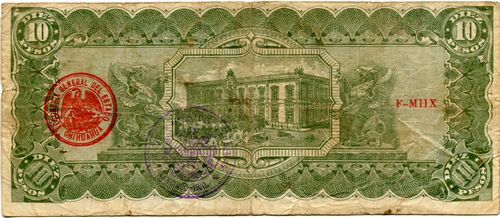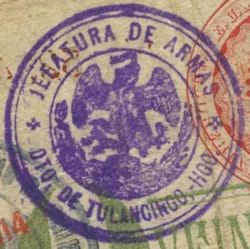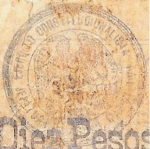The revolution in Hidalgo
The Constitutionalist Army entered Pachuca on 4 August 1914 and brought their money with them. In early September the Periódico Oficial reprinted most of Carranza’s more recent monetary decrees, such as decree núm. 18Periódico Oficial, Tomo XLVII, Núm. 67, 8 September 1914, decree núm. 21ibid., decree núm. 22ibid., decree núm. 24ibid., decree núm. 26ibid., decree núm. 33Periódico Oficial, Tomo XLVII, Núm. 66, 4 September 1914 and the decree increasing the fractional currencyPeriódico Oficial, Tomo XLVII, Núm. 67, 8 September 1914.
Off his own bat the new provisional governor, Nicolás Flores, prohibited the circulation of Obligaciones Provisionales on 10 August[text needed] and then rowed back on 1 September Periódico Oficial, Tomo XLVII, Núm. 66, 4 September 1914.
In October the Administración Principal de la Renta del Timbre also reaffirmed that it would accept the Ejército Constitucionalista cartones and notesPeriódico Oficial, Tomo XLVII, Núm. 76, 12 October 1914 and Villa’s sábanasPeriódico Oficial, Tomo XLVII, Núm. 78, 20 October 1914.
Revalidations
At some stage some of these Constitucionalist issues were revalidated in a couple of towns in the state.
Tulancingo
Tulancingo is the second-largest city in Hidalgo, located in the south-eastern part of the state. It was captured by Convention forces under General J. Mendez on 2 May 1915.

 A 34mm circular stamp with ‘JEFATURA DE ARMAS - DTO DE TULANCINGO, HGO.’ and eagle in centre is known on Ejército Constitucionalista notes, sábanas and dos caritas.
A 34mm circular stamp with ‘JEFATURA DE ARMAS - DTO DE TULANCINGO, HGO.’ and eagle in centre is known on Ejército Constitucionalista notes, sábanas and dos caritas.
Capula
Capula is a small town 25 kilometres west of Pachuca.
 ‘EJÉRCITO CONSTITUCIONALISTA - JEFATURA DE ARMAS, CAPULA, HGO is known on sábanas.
‘EJÉRCITO CONSTITUCIONALISTA - JEFATURA DE ARMAS, CAPULA, HGO is known on sábanas.
Batallón de Zapadores
‘Batallón de Zapadores, Hidalgo’ is known on sábanas.
In December the government published the Convention’s decree disowning the later Gobierno Provisional de México issues and revalidating others and its clarificationPeriódico Oficial, Tomo XLVII, Núm. 96, 28 December 1914.
The Carrancistas
On 13 February 1915 the Carrancista general Fortunato Maycotte took over as Governor and Comandante Militar and on the same day the two Chihuahuan issues were declared worthless. Various mining companies were allowed to issue vales to provide the necessary small change, whilst offices were set up to exchange the notesPeriódico Oficial, 16 February 1915 and on 19 February the Secretario General threatened businesses that bought them for a pittancePeriódico Oficial, Tomo XLVIII, Núm. 14, 20 February 1915. The next day the Periodico Oficial published the clarifications on the status of various issuesibid.. Since businesses were refusing to accept Durango notes that were decreed to be of forced circulation the government stressed the obligation to accept themPeriódico Oficial, Tomo LXVIII, Núm. 16, 28 February 1915.
On 12 March 1915 the Hidalgo state government issued a list of the notes from regional commanders that were of forced circulation, under threat of a fine or imprisonmentAH, Fondo Atotonilco el Grande, Sección Gobierno: Serie: Bandas y Decretos, Caja 77, Exp. 10: Periódico Oficial, Tomo LXVIII, Núm. 20, 12 March 1915. A later notice, on 31 March, added two other issues, including the Obligaciones ProvisionalesPeriódico Oficial, Tomo LXVIII, Núm. 25, 1 April 1915. The day before the government had had to counter the rumour that they were going to abandon the city and threaten businesses that refused to accept its currencyibid..
On the evening of 16 July Villistas under the command of Mayor José Kotuscey entered Pachuca and the next day Kotuscey, as Comandante Militar, advised[text needed] that all notes were to be of forced circulation, whether Villista or Carrancista. However, nine days later, after fights between the factions, Kotuscey was captured by Constitutionalist forces and shot. The Constitutionalists in turn entered Pachuca and on 29 July the new Comandante Militar, General José de la Luz Romero, issued a manifesto[text needed] that included that the notes known as dos caritas and revalidados altos were null and void. The dos caritas had been widespread.
Thereafter the Periódicos Oficiales reproduced Carranza's currency edicts. For instance, it published Carranza's circular núm. 48 on New Year's Day 1916Periódico Oficial, Tomo LXIX, Núm. 1, 1 January 1916 and this was circulated by Pachuca's preboste, Eduardo Cisneros, on 24 FebruaryAH, Fondo Atotonilco el Grande, Sección Gobierno: Serie: Bandas y Decretos, Caja 77, Exp. 32.
There were also some local notices. On 15 December 1915 Cisneros warned that Ejército Constitucionalista and Veracruz notes were of forced circulation even if they did not have the required revalidationPeriódico Oficial, Tomo LXIX, Núm. 1, 1 January 1916. On 9 March the Administrador Principal de la Renta de Timbre, F. Cataño, reported that all counterfeit notes, even with resellos, should be withdrawnPeriódico Oficial, Tomo LXIX, Núm. 11, 24 March 1916 and the next day the Secretario General A. Lazo de la Vega, reiterated that Ejército Constitucionalista and Veracruz notes without resellos were still of forced circulationPeriódico Oficial, Tomo LXIX, Núm. 12, 1 April 1916.
On 6 June Nicolás Flores, the governor of Hidalgo, issued instructions to businesses about currency and pricesAH, Fondo Atotonilco el Grande, Sección Gobierno: Serie: Bandas y Decretos, Caja 77, Exp. 51.
On 26 June the Hidalgo state government ordered the President de la Junta de Administración Civil to tell the Tesorero Municipal in Tula, and other Presidentes Municipales, to send all the Ejército Constitucionalista and Veracruz notes to the Administración de Rentas by 29 June to be exchanged for infalsificablesAH, Fondo Tula, Sección Gobierno: Serie: Hacienda/Tesorería, Caja 264, Exp. 7.
